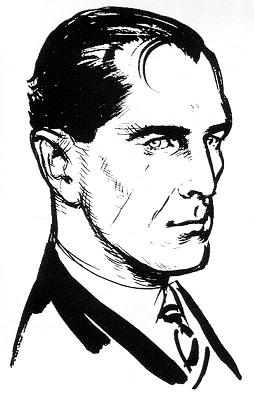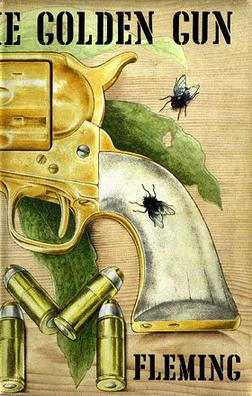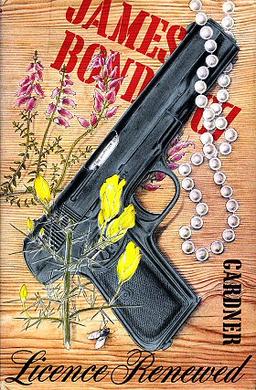External links
- Interview on Snelling https://web.archive.org/web/20130927015549/http://www.spywise.net/untold1.html
| Literature | |
|---|---|
| Films | |
| Video games | |
| Television | |
| Comics | |
| Characters | |
| Accessories | |
| Related | |
Double O Seven, James Bond, A Report (1964), by O. F. (Oswald Frederick) Snelling, is the first book-length, critical analysis of the James Bond novels, and the only such study Ian Fleming approved. It was published in August 1964, the month when Fleming died, a coincidence that earned the book's first edition a wide readership.
A lifelong devotee of British thriller writers, Snelling was a professional antiquarian working in the Hodgson auction house, where he met Ian Fleming, who had gone there to do research. In the course of writing James Bond, A Report, he learned that novelist Kingsley Amis also was writing a like study, so, Snelling worked quickly to ensure that his book would be published first. He succeeded; Amis's scholarly, literary, critical study, The James Bond Dossier (1965), was published in late 1965. Since then, the books are compared; some aficionados consider Snelling's book the superior contribution to the field of critical literary studies of James Bond. In Britain, Panther Books reprinted Double O Seven, James Bond, A Report in paperback; it was translated to and published in French, Dutch, Portuguese, Japanese, and Hebrew editions. In the U.S., the New American Library, Fleming's North American publishers, issued it in 1965.
O.F. Snelling's literary criticism of agent 007 is a five-part report. First, “His Predecessors”, observes the similarities among the upper-class “Clubland Tradition” novelists John Buchan, Sapper (H. C. McNeile), and Dornford Yates (Cecil William Mercer) and their influence upon the writer Ian Fleming. Second, “His Image” analyses the character, James Bond, secret agent 007 of the British Secret Service. Third, “His Women”, the longest section, examines and explores the women and Bond's relationships with them, and how they — the man and the women — changed in the series’ course. Fourth, “His Adversaries” examines the villains — Le Chiffre, Dr. No, Mister Big, Ernst Stavro Blofeld et al. — and describes their social, political, and personal motivations for doing evil, especially against Britain. The final, fifth section, “His Future” examines the literary and cinematic possibilities for the Bond character in 1964 — when Fleming was still writing. Moreover, given the business exigencies of publishing, You Only Live Twice (1964), then the latest novel, published in March 1964, Snelling incorporated to his Report only by way of footnotes.
The final page of Double O Seven, James Bond, A Report is an in-joke, between writer and reader, a reproduction of the watermark Snelling noticed in his typing paper: “64 Mill Bond — Extra Strong”.
Decades after original publication in 1964, O. F. Snelling hoped to publish Double O Seven: James Bond Under the Microscope a revised and updated edition including proper discussions of You Only Live Twice (1964) and The Man with the Golden Gun (1965), Fleming's last two novels, and the short stories in Octopussy (1966); the last two books had been published posthumously and after the original Report’s 1964 publication. The title of the new edition is in fact was Snelling’s original, full title for the 1964 edition of the Report, which had been retitled by the publisher — against Snelling’s wishes. [1] The new edition would also include discussions of the Kingsley Amis and John Gardner continuation novels, and the film series, which had been touched on only incidentally in the 1964 edition.
In 1980, he wrote “Apropos Double O Seven” a preface to Double O Seven: James Bond Under the Microscope, but the revised, updated, and re-titled book went unpublished until 2007, when Ronald Payne, his literary executor, published it online; it includes a collection of Snelling–Payne correspondence. In the preface and the writer–executor correspondence, Snelling stresses his preference for the literary 007, because he felt the film series’ interpretation, especially Roger Moore’s entries, abandoned the adult secret agent character Ian Fleming created; ultimately, O. F. Snelling lost interest in all things Bond.

The James Bond series focuses on a fictional British Secret Service agent created in 1953 by writer Ian Fleming, who featured him in twelve novels and two short-story collections. Since Fleming's death in 1964, eight other authors have written authorised Bond novels or novelisations: Kingsley Amis, Christopher Wood, John Gardner, Raymond Benson, Sebastian Faulks, Jeffery Deaver, William Boyd, and Anthony Horowitz. The latest novel is With a Mind to Kill by Anthony Horowitz, published in May 2022. Additionally Charlie Higson wrote a series on a young James Bond, and Kate Westbrook wrote three novels based on the diaries of a recurring series character, Moneypenny.

Ian Lancaster Fleming was a British writer who is best known for his postwar James Bond series of spy novels. Fleming came from a wealthy family connected to the merchant bank Robert Fleming & Co., and his father was the Member of Parliament (MP) for Henley from 1910 until his death on the Western Front in 1917. Educated at Eton, Sandhurst, and, briefly, the universities of Munich and Geneva, Fleming moved through several jobs before he started writing.

Moonraker is the third novel by the British author Ian Fleming to feature his fictional British Secret Service agent James Bond. It was published by Jonathan Cape on 5 April 1955 and featured a cover design conceived by Fleming. The plot is derived from a Fleming screenplay that was too short for a full novel, so he added the passage of the bridge game between Bond and the industrialist Hugo Drax. In the latter half of the novel, Bond is seconded to Drax's staff as the businessman builds the Moonraker, a prototype missile designed to defend England. Unknown to Bond, Drax is German, an ex-Nazi now working for the Soviets; his plan is to build the rocket, arm it with a nuclear warhead, and fire it at London. Uniquely for a Bond novel, Moonraker is set entirely in Britain, which raised comments from some readers, complaining about the lack of exotic locations.

The Man with the Golden Gun is the twelfth and final novel in Ian Fleming's James Bond series and thirteenth Bond book overall. It was first published by Jonathan Cape in the UK on 1 April 1965, eight months after the author's death. The novel was not as detailed or polished as the others in the series, leading to poor but polite reviews. Despite that, the book was a best-seller.

Octopussy and The Living Daylights is the 14th and final James Bond book written by Ian Fleming in the Bond series. The book is a collection of short stories published posthumously in the United Kingdom by Jonathan Cape on 23 June 1966.
Ian Fleming Publications is the production company formerly known as both Glidrose Productions Limited and Glidrose Publications Limited, named after its founders John Gliddon and Norman Rose. In 1952, author Ian Fleming bought it after completing his first James Bond novel, Casino Royale; he assigned most of his rights in Casino Royale, and the works which followed it to Glidrose.

Colonel Sun is a novel by Kingsley Amis published by Jonathan Cape on 28 March 1968 under the pseudonym "Robert Markham". Colonel Sun is the first James Bond continuation novel published after Ian Fleming's 1964 death. Before writing the novel, Amis wrote two other Bond related works, the literary study The James Bond Dossier and the humorous The Book of Bond. Colonel Sun centres on the fictional British Secret Service operative James Bond and his mission to track down the kidnappers of M, his superior at the Secret Service. During the mission he discovers a communist Chinese plot to cause an international incident. Bond, assisted by a Greek spy working for the Russians, finds M on a small Aegean island, rescues him and kills the two main plotters: Colonel Sun Liang-tan and a former Nazi commander, Von Richter.
Per Fine Ounce is the title of an unpublished novel by Geoffrey Jenkins featuring Ian Fleming's James Bond. It was completed c.1966 and is considered a "lost" novel by fans of James Bond because it was actually commissioned by Glidrose Productions, the official publishers of James Bond. It was rejected for publication, however, missing the opportunity to become the first continuation James Bond novel. The Adventures of James Bond Junior 003½, a novel written by the pseudonymous R. D. Mascott, was later published in 1967 featuring James Bond's nephew; Colonel Sun written by Kingsley Amis under the pseudonym Robert Markham was published in 1968 as the first adult continuation novel following Ian Fleming's The Man with the Golden Gun (1965).

Licence Renewed, first published in 1981, is the first novel by John Gardner featuring Ian Fleming's secret agent, James Bond. It was the first proper James Bond novel since Kingsley Amis's Colonel Sun in 1968. Carrying the Glidrose Publications copyright, it was first published in the United Kingdom by Jonathan Cape and in the United States by Richard Marek, a G. P. Putnam's Sons imprint.

For Special Services, first published in 1982, was the second novel by John Gardner featuring Ian Fleming's secret agent, James Bond. Carrying the Glidrose Publications copyright, it was first published in the United Kingdom by Jonathan Cape and in the United States by Coward, McCann & Geoghegan. Cover designed by Bill Botten.
In the 1950s and 1960s, Ian Fleming, creator of the fictional secret agent, James Bond, wrote a number of short stories featuring his creation that appeared in the collections For Your Eyes Only and Octopussy and The Living Daylights. Since 1997, several more short stories featuring Bond or set within the official James Bond universe have been published by authors who continued chronicling the world of Fleming's creation. The majority of these stories have, as of 2008, never been collected in book form, unlike the Fleming works. There are five exceptions: "Blast from the Past", "Midsummer Night's Doom" and "Live at Five" by Raymond Benson, "Your Deal, Mr. Bond" by Phillip and Robert King, and "Bond Strikes Camp" by Cyril Connolly which are discussed below.

James Bond, The Spy Who Loved Me is the official novelization of the 1977 Eon James Bond filmThe Spy Who Loved Me, which was itself inspired by the 1962 novel of the same title by Ian Fleming.
James Bond was a comic strip that was based on the eponymous, fictional character created by author Ian Fleming. Starting in 1958 and continuing to 1983, it consisted of 52 story arcs that were syndicated in British newspapers, seven of which were initially published abroad.

The James Bond Dossier (1965), by Kingsley Amis, is a critical analysis of the James Bond novels. Amis dedicated the book to friend and background collaborator, the poet and historian Robert Conquest. Later, after Ian Fleming's death, Amis was commissioned as the first continuation novelist for the James Bond novel series, writing Colonel Sun (1968) under the pseudonym Robert Markham. The James Bond Dossier was the first, formal, literary study of the James Bond character. More recent studies of Fleming's secret agent and his world include The Politics of James Bond: From Fleming's Novels to the Big Screen (2001), by the historian Jeremy Black.

Casino Royale is the first novel by the British author Ian Fleming. Published in 1953, it is the first James Bond book, and it paved the way for a further eleven novels and two short story collections by Fleming, followed by numerous continuation Bond novels by other authors.

The Book of Bond or, Every Man His Own 007 is a book by Kingsley Amis which was first published by Jonathan Cape in 1965. For this work, Amis used the pseudonym Lt.-Col. William ("Bill") Tanner. In Ian Fleming's James Bond novels, Bill Tanner is M's chief of staff and a recurring character throughout the series.
O. F. Snelling was an author and auctioneer clerk in the antiquarian book trade.

Commander James Bond is a character created by the British journalist and novelist Ian Fleming in 1953. He is the protagonist of the James Bond series of novels, films, comics and video games. Fleming wrote twelve Bond novels and two short story collections. His final two books—The Man with the Golden Gun (1965) and Octopussy and The Living Daylights (1966)—were published posthumously.
The following outline is provided as an overview of and topical guide to James Bond: